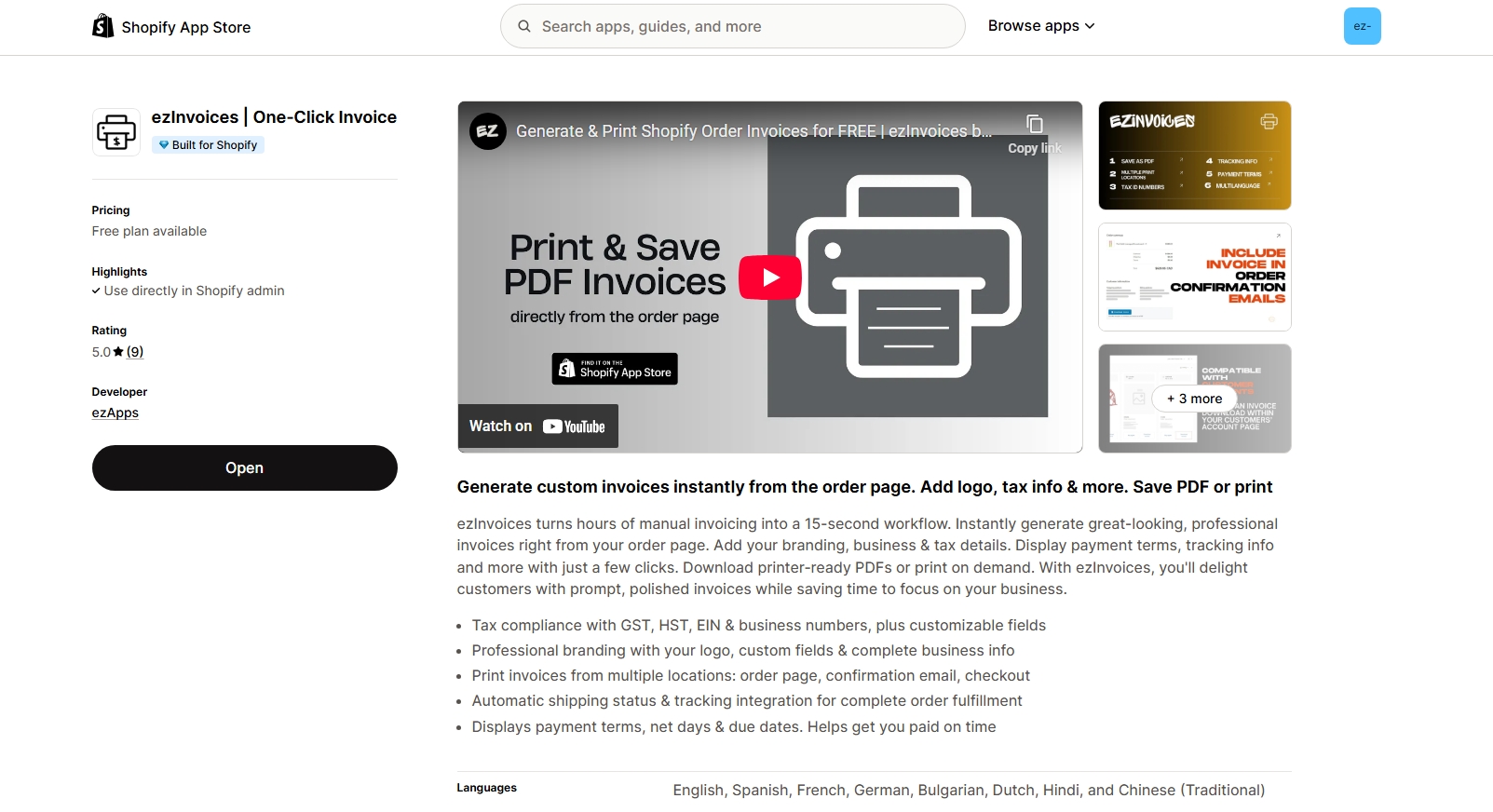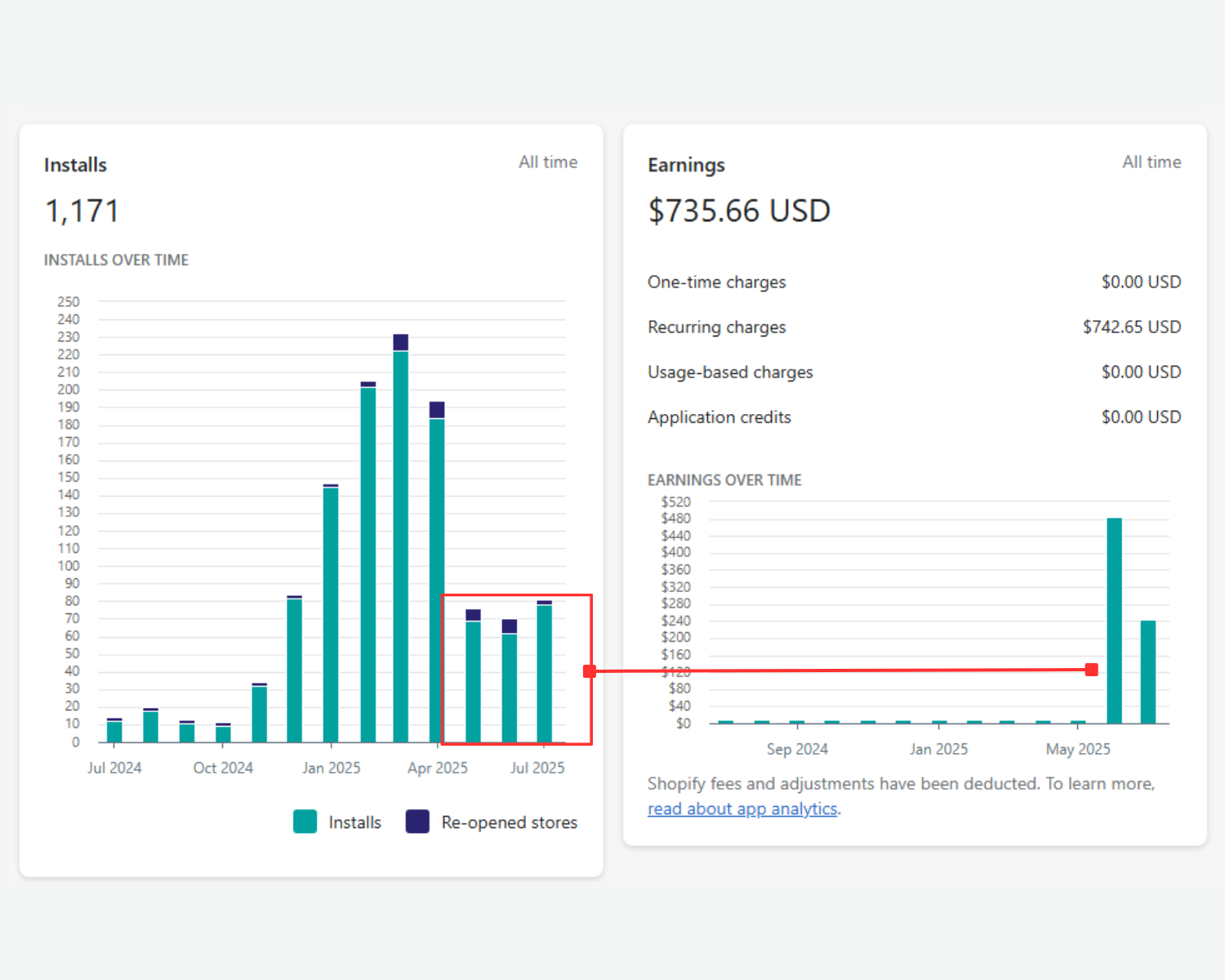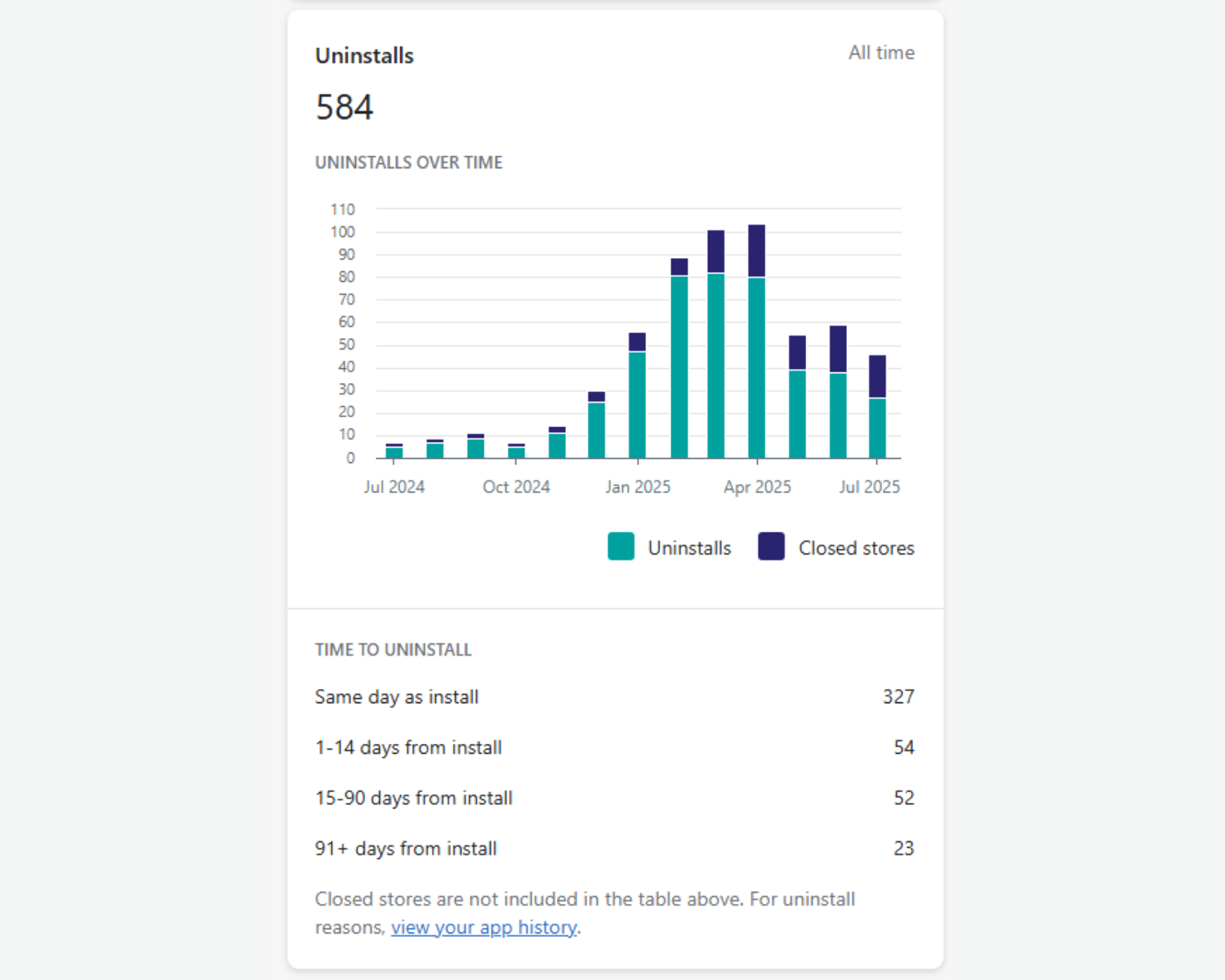
My Shopify App After One Year
The unfiltered truth about building a Shopify app - 587 merchants, $735 revenue, and lessons learned from a year of bootstrapping ezInvoices.

The Numbers Don't Lie (But They Don't Tell the Whole Story)
After 365 days in the Shopify App Store, ezInvoices ↗ has:
- 587 active merchants
- Generated $735.66 in revenue
- Achieved Built for Shopify status
- Maintained a 5-star rating with 9 reviews
If you're reading this expecting a "how I made $10K/month" story, this isn't it. This is the real, unfiltered journey of building a Shopify app as a solo developer with zero marketing budget and a full-time job.
From Internal Tool to Public App
ezInvoices started as a solution to my own problem. Working at a company that needed a simple way to generate invoices for customers, I built what we needed. But somewhere between July and October 2024, I realized this could help other merchants too.
The transition from "internal tool" to "public app" wasn't just about listing it on the App Store. It was about shifting my mindset from "does this work for us?" to "will this work for everyone?"

The Growth Timeline: Four Pivotal Moments
1. October 2024: The Community Forum Strategy
With no marketing budget and no idea how to promote an app, I turned to the Shopify Community forums ↗. My strategy was simple:
- Search for keywords related to "invoice," "invoicing," and "print orders"
- Find merchants asking for solutions
- Genuinely help them by suggesting ezInvoices when it was a good fit
This grassroots approach kept us hovering around 30 merchants for months, but it laid the foundation for organic growth.
I remember I had no clue how to market this thing, and definitely didn't have the money to spend on ads.
2. November 2024: The First 5-Star Review
I'll never forget the notification. Our first 5-star review felt like winning an award. I texted my wife immediately (she was probably tired of my daily install count updates by then).
That single review created a noticeable bump in installs. It validated that we were solving a real problem and gave potential users confidence to try the app.
I remember freaking out and being so excited. I would text my wife every time someone new installed my app.
3. April 2025: The Billing Dilemma
By April, we had grown to ~400 merchants. Server costs were mounting, and some power users were generating 1,000+ invoices per month. It was time to introduce billing.
I was terrified. Would everyone uninstall? Would growth completely stop?
The results were mixed:
- Growth did slow significantly
- But uninstalls actually decreased
- The merchants who stayed were more engaged and invested
Using Shopify's Managed Pricing ↗, I designed a plan where 80% of users could continue using the app for free, while the top 20% would support everyone else.
I created a banner with a message from me so that when merchants saw they needed to upgrade their billing plan, they saw a message from me explaining the situation.
4. June 2025: Built for Shopify Achievement
After months of preparation, feedback implementation, and anxious waiting, we received Built for Shopify ↗ status. The process took 2-3 months, but mainly because I was busy working on my other app, Sagify, and kept putting the feedback aside. I could have unlocked BFS status much sooner if I had jumped on the changes right away—the actual process is quite fast.
The feedback from Shopify was minimal—just a few UI adjustments like adding the Contextual Save Bar ↗ and improving my settings page visual editor.
The immediate impact was visible - a nice uptick in installs and increased credibility in the marketplace.
The Unvarnished Truth About Numbers

Let's talk about what 587 merchants and $735.66 really means:
Installs vs. Uninstalls:
- Total installs: 1,171
- Total uninstalls: 584
- Retention rate: ~50%

This 50% retention might seem low, but it's actually quite normal for Shopify apps, especially free ones. Many "installs" are from:
- Developers exploring the ecosystem
- New stores testing Shopify
- Merchants comparison shopping
Revenue Reality: $735.66 over 12 months averages to about $61 per month. After Shopify's cut and server costs, it's not profitable yet. But that's okay - this year was about learning and building a foundation.
Key Lessons Learned
1. Introduce Billing Early
If I could do it over, I'd introduce billing within the first month or two. Free users rarely provide feedback, rarely engage, and create support burden without contributing to sustainability.
All the feedback I've ever received on my app were from stores that would eventually sign up for a subscription.
2. Reviews Come from Great Support
I never bought reviews (don't do it - it's against TOS and unethical). Instead, I focused on responding to support requests within hours, sometimes minutes. Happy merchants leave reviews naturally.
Often times, it was a merchant reaching out to me by email with an issue or a feature request, and at the time my goal was to get it solved within the day. Often I would have the new feature or bug fix done within the hour. I wanted them to feel like I was an amazing asset that they could count on in their business.
Last month, I implemented the new Shopify App Bridge Reviews API so users can leave reviews directly within the app, making the process even smoother.
3. Built for Shopify is Worth the Effort
The credibility boost and increased visibility make it worthwhile. Merchants can filter by this badge, giving you a competitive advantage. The actual approval process is quite fast if you're responsive to feedback—my 2-3 month timeline was entirely due to my own delays.
4. Community Engagement Works
Without a marketing budget, authentic community participation was our primary growth driver. One well-placed, helpful comment can drive installs for months.
What's Next for ezInvoices?
Year two is about:
- Improving the billing model based on user feedback
- Adding requested features from our paying customers
- Exploring partnerships and integrations
- Building on the foundation we've created
The Reality of Shopify App Development
Building a Shopify app isn't a get-rich-quick scheme. It's a marathon of:
- Late nights fixing bugs
- Constant learning and adaptation
- Building relationships with merchants
- Balancing feature requests with sustainability
But here's the thing—every morning I still log into my Shopify Partner dashboard to see how many installs we got today, even at 587 merchants. I love seeing that number go up, or when someone new buys a subscription. There's something addictive about watching your creation grow, no matter how slowly.
Final Thoughts
ezInvoices' first year wasn't about explosive growth or massive profits. It was about proving the concept, learning the ecosystem, and building something merchants actually need.
If you're thinking about building a Shopify app, know this: success isn't always measured in dollars. Sometimes it's measured in problems solved, lessons learned, and foundations built for future growth.
Here's to year two - may it bring new challenges, new merchants, and new opportunities to make commerce better for everyone.
Want to follow along with ezInvoices' journey? Check out the app on the Shopify App Store ↗ or follow our development blog at ezApps.io
Related Reading
Continue the Series:
- Part 2: How I Grew My Shopify App to 587 Merchants - The exact growth strategies that worked
- Part 3: Is Built For Shopify Worth It? - Real data on BFS impact
- Part 4: Do Shopify Apps Make Money? - First year revenue report
Other Resources:
- How to Create Professional Invoices in Shopify - A guide for merchants
- Shopify App Bridge Reviews API Guide - Technical implementation guide
Share this article: